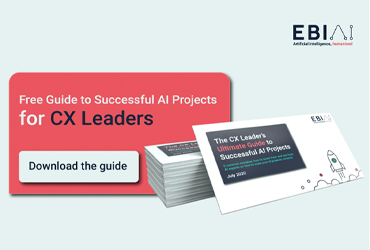A 5-step checklist for mastering enterprise AI; Artificial Intelligence is here to stay but how do you turn hype into reality? Abbie Heslop at EBI.AI applies a few real-life lessons to provide CX leaders with a practical pathway to AI success.
Customer service leaders and chief information officers (CIOs) are often asked what are they doing about artificial intelligence and automation. But how easy is it to separate hype from reality?
At EBI.AI, we have spent over six years working closely with our customers to implement conversational AI projects for a wide range of organisations including retail, local government and multi-national enterprises. This means we have learned many valuable lessons and witnessed AI success first-hand.
5 steps to AI success
Here are our top five steps to mastering and championing AI projects:
» Know what you want to achieve and communicate it – the first step starts with defining what AI success means to your organisation. Are your goals financial in nature, involving cost savings or revenue targets? Do they centre around increasing customer engagement? Or are they purely operational, seeking to improve efficiency such as reduced average handling time (AHT), time to answer or to reduce call volumes in general? Perhaps your objectives are more qualitative and based on measures of customer satisfaction, customer effort and customer lifetime value? Establish the end-goal, making sure to communicate it to key stakeholders so everyone understands the organisational and project objectives, and what success looks like.
» Select the right data – AI tools such as bots, chatbots and digital assistants are only as good as the data used to train them. Establish what really matters to your customers and train AI to answer the right questions. Next, focus on collecting representative data samples. An effective and low risk way to do this is to create a Minimum Viable Assistant (MVA) that is trained on a small amount of carefully curated data and then released to a controlled percentage of customers to collect real-world data. At this stage, it is important to be open with customers that the virtual assistant is in training. When it is asked questions which it cannot answer, it will hand over to a live agent. Using this approach, customer experience (CX) leaders can quickly identify what customers want and track intent trends to train the AI tool to learn from each interaction.
» Start small and dedicate internal resources to the project, pre- and-post launch – conversational AI projects are not ‘plug and play’ and with machine learning, the more AI tools are used, the better they get. This means that investment, engagement and training in AI projects and the tools designed to enhance customer interactions are a continual learning and improvement process. CX leaders have a pivotal role to play in deciding the approach they take based on their internal team’s capabilities. Options include working with their chosen AI vendor in terms of enterprise offerings, self-service or as a managed service.
» Don’t try to replace your people – after all, despite the benefits Natural Language Processing that AI tools offer, many customers still crave the personal service provided by another human being. Consider using AI technology in tandem with live agents to deal with demand while still offering a personalised customer service when required. AI-driven solutions such as chatbots and digital assistants empower agents to provide a faster and more accurate service to customers. For example, they can answer simple queries quickly while automatically providing all the contextual information agents need, including a customer’s previous conversation and even mood – to deliver a seamless and engaging conversation.
» Take piloting seriously – wise CX leaders always test their AI projects before they go live. Don’t rush this crucial stage. However long a pilot project takes, it is an essential step before full production in order to hone the solution, integrate it with the company’s infrastructure and show it delivers the CX and financial benefits that stakeholders demand.
Whenever a new iteration of the AI tool is released, remember to monitor key metrics that reflect and reinforce your original goals such as ‘What % of users engage with the assistant?’, ‘What are the most popular topics?’ How many visitors request transfer to a live agent?’ and ‘Does the assistant need extra training?’
Along the way, AI and Natural Language Processing pilots often present digital transformation opportunities by identifying specific enterprise system or product issues that can impact the customer experience. The beauty of testing is that failures provide valuable lessons learned that can be applied to ensure the success of the final roll-out programme.

Established in 2014, EBI.AI is among the most advanced UK labs to create fully managed, Enterprise-grade AI assistants. These assistants help clients to provide their customers with faster and better resolutions to their queries, and liberate front-line customer service agents from the dull, repetitive and mundane.
EBI.AI selects the best AI and cloud services available from IBM, Amazon, Microsoft and others, combined with bespoke AI models to deliver its AI communication platform, called Lobster.
Combined with it over 19 years of experience working with big data, analytics and systems integration it has successfully implemented AI assistants that now handle hundreds of thousands of conversations a year across Transport & Travel, Property, Insurance, Public and Automotive industries.
Your pathway to AI success starts with this 5-step checklist. For more ideas and inspiration, download ERBI.AI’s latest white paper entitled “The CX Leader’s Ultimate Guide to Successful AI Projects”.
For additional information on EBI.AI visit their Website





